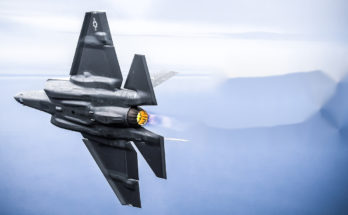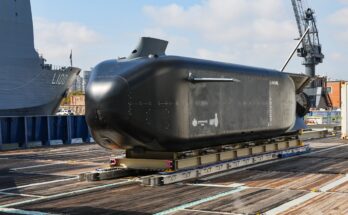The Australian government signed a Strategic Partnering Agreement (SPA) with French shipbuilder Naval Group on February 11, signaling firm commitment toward the production and delivery of new-build attack submarines for the Royal Australian Navy (RAN) under its SEA 1000 Future Submarine requirement.
The AUD50 billion ($35.5 billion) Future Submarine program involves building 12 submarines that will serve as a successor class to the Royal Australian Navy’s current six-sub Collins class fleet.
Today is a defining moment for Australia with the formal signing of a $50b agreement to build 12 submarines in Australia for the Navy.
This agreement will create around 2,800 jobs for Australians, while helping to protect our country and keep Australians safe.#StrongerAus pic.twitter.com/TqGDIgn95T
— Scott Morrison (@ScottMorrisonMP) February 11, 2019
Naval Group was selected by Australia in April 2016 for the design phase of the program after offering up a diesel-electric variant – the Shortfin Barracuda Block 1A – of its nuclear-powered Barracuda attack submarine built for the French Navy. An AUD500 million three-year contract for early design work followed on September 29, 2016.
Under the program’s outline, the first new 4,700-ton Shortfin Barracuda submarine is to be delivered to the RAN and reach full-mission capability around 2034, with the remainder of the project to be wrapped up in the 2050s.
The signing of the SPA followed months of intense, often acrimonious negotiations between the two sides over a variety of issues, including warranties for defects, penalty clauses for cost overruns, and concerns over the level of French technology transfer to Australian industry.
Over the course of the negotiations, the program achieved two milestones with the completion of both the pre-sizing of the new Future Submarine and the Feasibility Study phase, the latter undertaken in France with the cooperation of Australian engineers to ensure overall program functionality and scheduling, and that cost requirements are met.
By December a level of consensus had finally emerged between the Australian government and Naval Group. This allowed work to begin on a construction yard in Adelaide where the submarines will be built, with dirt being cleared for earth works and pilings for the new facilities prior to inking the SPA.
The formal design phase will also move forward, and suppliers of the five core components – the main motor, the diesel generators, the switchboards, the batteries, and the weapons discharge systems – will be announced in 2019.
Construction of the lead-in submarine is to kick off in 2023.
Going forward, there remains concern regarding exactly how much Australian industrial content will be involved in the submarines. Defence Minister Christopher Pyne had initially promised a minimum of 90 percent Australian content. Other issues of scrutiny involve whether the project can achieve its stated delivery timelines, net cost-versus-capability, and whether Australia should undertake a Service Life Extension Program on the current Collins submarines in order to prevent the emergence of a capability gap in the early 2040s while delivery of the newer models proceeds.
Some of these concerns and others were echoed earlier in a report by Australian consulting firm Insight Economics published in September 2017. That report labeled the Future Submarine program excessively expensive and technically risky, adding that it had dubious long-term value. It suggested purchasing an evolved variant of an existing type of submarine to prevent a capability gap during the transition from the Collins to the newer-generation models.
All of these questions will remain through the upcoming May election cycle and beyond. At the very least, a review of the program may be called for should the political opposition prove victorious at the polls. Otherwise, the SPA reportedly retains a provision whereby the government may break the contract at any point, albeit at a cost of millions in financial compensation for Naval Group.
For now, however, it’s full steam ahead for Australia’s most expensive military program to date.

Image via Royal Australian Navy
Dan Darling is Forecast International’s director of military and defense markets. In this role, Dan oversees a team of analysts tasked with covering everything from budgeting to weapons systems to defense electronics and military aerospace. Additionally, for over 17 years Dan has, at various times, authored the International Military Markets reports for Europe, Eurasia, the Middle East and the Asia-Pacific region.
Dan's work has been cited in Defense News, Real Clear Defense, Asian Military Review, Al Jazeera, and Financial Express, among others, and he has also contributed commentary to The Diplomat, The National Interest and World Politics Review. He has been quoted in Arabian Business, the Financial Times, Flight International, The New York Times, Bloomberg and National Defense Magazine.
In addition, Dan has made guest appearances on the online radio show Midrats and on The Media Line, as well as The Red Line Podcast, plus media appearances on France 24 and World Is One News (WION).




